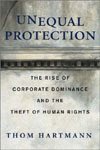 Unequal Protection: The rise of corporate dominance and theft of human rights
Unequal Protection: The rise of corporate dominance and theft of human rights
by Thom Hartmann
Discover more about "Unequal Protection"
Buy from Amazon
HISTORICAL DODUMENTS
Marking some milestones in the corporate theft of human rights
Below is the letter from Supreme Court Chief Justice Morrison Remick Waite to court reporter J.C. Bancroft Davis informing Davis that it didn't much matter whether or not he included a comment about the arguments before the court that corporations were persons "as we avoided meeting the constitutional questions in the decision."
The decision did not rule that corporations are persons: Davis added it in the headnotes (commentary) on his own, and subsequent courts have incorrectly based decisions since 1886 on the headnotes and not the case. (Thanks to Michael Kinder, who found this in the J.C. Bancroft Davis collection of personal papers in the National Archives in Washington, DC, where they had been sitting, unnoticed, for over a century.)
The letter from Davis to Waite asking if he got the comments right precedes Waite's response. Davis writes, after quoting language stating that corporations are persons, "please let me know whether I correctly caught your comments and oblige [reply]."

In his reply to Davis, Waite writes: "I think your mem. in the California Rail Road tax cases expresses with sufficient accuracy what was said before the arguments began. I leave it with you to determine whether anything need be said about it in the report inasmuch as we avoided meeting the Constitutional question in the decision."


Official photo of Supreme Court Chief Justice Morrison R. Waite, 1886, falsely accused by history of giving human rights to corporations.

This may be the only photo in existence of John Chandler Bancroft Davis (1822-1907), son of Massachusetts Governor John Davis (1787-1804), and former president of the Newburgh & New York Railroad, Assistant Secretary of State, Minister to Germany, and Reporter of the U.S. Supreme Court (in which capacity he authored the headnotes to the Southern Pacific Railroad vs. Santa Clara County case which defined corporate personhood, and the Plessey vs. Ferguson case which defined the "separate but equal" doctrine of racial segregation).
(Photo from "Three Generations of Northboro Davises 1781-1894" by John Davis Estabrook, self-published in 1908.)
 Delphin M. Delmas, the attorney who in 1882 successfully, singlehandedly, and pro bono argued before the California legislature to save the last remaining redwood trees in that state, and in 1886 made an eloquent and successful defense of "human rights for humans only" before the U.S. Supreme Court in 1885/1886 in the Santa Clara case. (Click here to see the chapter excerpt from Unequal Protection on the 1886 theft of human rights, which quotes extensively from his speech to the Court.) In the courtroom, Delmas was a brilliant dramatist, as the nation would learn in 1908 when he successfully defended Harry K. Thaw for murder in what was the most sensational case of the first half of the century, later made into the 1955 movie The Girl in the Red Velvet Swing starring Joan Collins, Luther Adler, and Ray Milland.
Delphin M. Delmas, the attorney who in 1882 successfully, singlehandedly, and pro bono argued before the California legislature to save the last remaining redwood trees in that state, and in 1886 made an eloquent and successful defense of "human rights for humans only" before the U.S. Supreme Court in 1885/1886 in the Santa Clara case. (Click here to see the chapter excerpt from Unequal Protection on the 1886 theft of human rights, which quotes extensively from his speech to the Court.) In the courtroom, Delmas was a brilliant dramatist, as the nation would learn in 1908 when he successfully defended Harry K. Thaw for murder in what was the most sensational case of the first half of the century, later made into the 1955 movie The Girl in the Red Velvet Swing starring Joan Collins, Luther Adler, and Ray Milland.
(Photo from "Speeches and Addresses" by D.M. Delmas, published in 1901 in San Francisco by A.M. Robertson.)
Discover more about "Unequal Protection"



